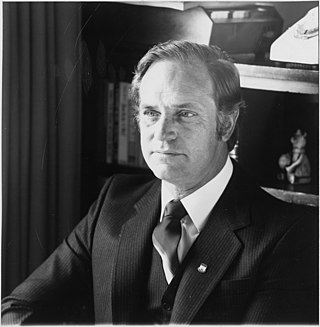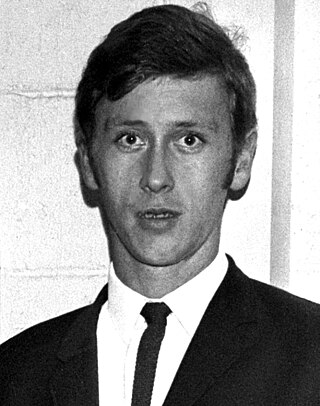
The New Zealand Social Credit Party was a political party that was New Zealand's third party from the 1950s to the 1980s. It won representation in the New Zealand House of Representatives, holding one seat at times between 1966 and 1981, and two seats from 1981 to 1987. While Social Credit once had significant support, particularly as a protest vote, it was disadvantaged by first-past-the-post voting as it had no geographically concentrated vote. Its most identifiable leaders were Vernon Cracknell (1963-70), who served just one term in parliament, and the household name Bruce Beetham, who rebuilt the party into a significant political force. At its zenith under Beetham in 1981, Social Credit achieved an unprecedented 20.7% of the vote.

The 1975 New Zealand general election was held on 29 November to elect MPs to the 38th session of the New Zealand Parliament. It was the first general election in New Zealand where 18- to 20-year-olds and all permanent residents of New Zealand were eligible to vote, although only citizens were able to be elected.

Bruce Craig Beetham was an academic and politician from New Zealand, whose career spanned the 1970s and early 1980s.

The 1978 New Zealand general election was a nationwide vote to elect the 39th New Zealand Parliament. It saw the governing National Party, led by Robert Muldoon, retain office, but the opposition Labour Party won the largest share of the vote. Reorganisation of the enrolment system caused major problems with the electoral rolls, which left a legacy of unreliable information about voting levels in this election.
The Christchurch Central by-election of 1979 was a by-election during the 39th New Zealand Parliament. It was prompted by the death of Bruce Barclay, a Labour Party MP, and resulted in Geoffrey Palmer, also of the Labour Party, being elected to replace him for the seat of Christchurch Central. Palmer would eventually go on to become Prime Minister. The by-election was somewhat embarrassing for the National Party, whose candidate was pushed into third place by Social Credit's Terry Heffernan.

Joanne Gay Goodhew is a New Zealand politician. She served as a member of Parliament between 2005 and 2017.

The Rangitikei by-election of 1978 was a by-election in the New Zealand electorate of Rangitikei, a predominantly rural district in the middle of New Zealand's North Island. The by-election occurred on 18 February 1978, and was precipitated by the death of sitting National Party member of parliament Sir Roy Jack in December 1977.
Maurice Patrick McTigue is a former New Zealand politician of the National Party. He was a Cabinet Minister in the Fourth National Government from 1990 to 1993, holding the Employment portfolio, among others. He represented the Timaru electorate in Parliament from 1985, when he won the by-election after the death of Sir Basil Arthur, having stood against him in the 1984 general election. He lost the seat to Jim Sutton in the 1993 general election.

Neville George Pickering was a New Zealand politician of the Labour Party.

Rangitata is an electorate in the South Island of New Zealand. It first existed for two parliamentary terms in the late 19th century and was re-established for the 2008 general election. It largely replaced the Aoraki electorate, but included parts of the Rakaia electorate as well.
Timaru was a parliamentary electorate, in New Zealand's South Island. It existed continuously from 1861 to 1996 and was represented by eleven Members of Parliament.
Ian Terence Quigley was a former New Zealand politician of the Labour Party.

The Sydenham by-election 1974 was a by-election held in the Sydenham electorate during the term of the 37th New Zealand Parliament on 2 November 1974. Eight candidates stood in total.
The Marlborough by-election of 1970 was a by-election for the electorate of Marlborough, held on 21 February 1970 during the 30th New Zealand Parliament.
The Pahiatua by-election of 1977 was a by-election for the electorate of Pahiatua on 30 April 1977 during the 38th New Zealand Parliament.
The Grey Lynn by-election 1963 was a by-election held in the Grey Lynn electorate in Auckland during the term of the 33rd New Zealand Parliament, on 18 May 1963.
The Hurunui by-election 1961 was a by-election held in the Hurunui electorate in North Canterbury during the term of the 33rd New Zealand Parliament, on 10 June 1961.

The Buller by-election 1962 was a by-election held in the Buller electorate in the West Coast during the term of the 33rd New Zealand Parliament, on 7 July 1962.

The Timaru by-election 1962 was a by-election held in the Timaru electorate in Canterbury during the term of the 33rd New Zealand Parliament, on 21 July 1962.

The Riccarton by-election 1956 was a by-election held in the Riccarton electorate in Christchurch during the term of the 31st New Zealand Parliament following the death of the Labour Party incumbent. The by-election, held on 27 October 1956, was won by Mick Connelly, also of the Labour Party.












